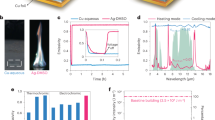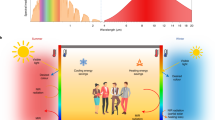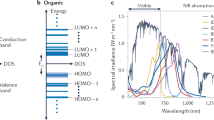Abstract
Electrochromic windows provide a sustainable solution for use in energy-efficient buildings as their varying optical properties in changing weather conditions allow the optimization of solar radiation heat gain and indoor thermal comfort. However, as the wavelength range of sunlight that can be used remains limited, broader implementation of this technology is hampered. Here we present an electrochromic design that combines radiative cooling of mid-infrared light and maximized utilization of both visible and near-infrared light. Our electrochromic window takes advantage of a WO3/VO2 film structure that, with a controllable lithium-ion intercalation depth, affords three active optical states to control visible and near-infrared transmittance independently. Moreover, the use of electrodes with preferred emissivity at both surfaces serves to optimize the radiative heat exchange between the indoor and outdoor environments. Field experiments and simulations show that our device exhibits higher energy savings than a commercial low-emissivity glass in most climate zones around the world. Our findings suggest ample opportunities for energy-saving window designs that can help achieve global carbon neutrality and sustainability.
This is a preview of subscription content, access via your institution
Access options
Access Nature and 54 other Nature Portfolio journals
Get Nature+, our best-value online-access subscription
$29.99 / 30 days
cancel any time
Subscribe to this journal
Receive 12 digital issues and online access to articles
$119.00 per year
only $9.92 per issue
Buy this article
- Purchase on Springer Link
- Instant access to full article PDF
Prices may be subject to local taxes which are calculated during checkout




Similar content being viewed by others
Data availability
All data needed to support the findings of this study are included in the main text or in Supplementary Information. The data associated with the Article have been deposited via Zenodo at https://zenodo.org/records/10815585 (ref. 38). The climate database used in this study is available at https://energyplus.net/weather.
References
Zhao, L., Lee, X., Smith, R. B. & Oleson, K. Strong contributions of local background climate to urban heat islands. Nature 511, 216–219 (2014).
Cuce, E. & Riffat, S. B. A state-of-the-art review on innovative glazing technologies. Renew. Sustain. Energy Rev. 41, 695–714 (2015).
Gao, Y. et al. Enhanced chemical stability of VO2 nanoparticles by the formation of SiO2/VO2 core/shell structures and the application to transparent and flexible VO2-based composite foils with excellent thermochromic properties for solar heat control. Energy Environ. Sci. 5, 6104–6110 (2012).
Shao, Z. et al. All-solid-state proton-based tandem structures for fast-switching electrochromic devices. Nat. Electron. 5, 45–52 (2022).
Barawi, M. et al. Dual band electrochromic devices based on Nb-doped TiO2 nanocrystalline electrodes. ACS Nano 11, 3576–3584 (2017).
Zhai, Y. et al. Recent advances on dual-band electrochromic materials and devices. Adv. Funct. Mater. 32, 2109848 (2022).
Zhang, S., Cao, S., Zhang, T., Fisher, A. & Lee, J. Y. Al3+ intercalation/deintercalation-enabled dual-band electrochromic smart windows with a high optical modulation, quick response and long cycle life. Energy Environ. Sci. 11, 2884–2892 (2018).
Kim, M. et al. Visibly transparent radiative cooler under direct sunlight. Adv. Opt. Mater. 9, 2002226 (2021).
Heo, S.-Y. et al. A Janus emitter for passive heat release from enclosures. Sci. Adv. 6, eabb1906 (2020).
Zhou, Y. et al. Liquid thermo-responsive smart window derived from hydrogel. Joule 4, 2458–2474 (2020).
Wen, R.-T., Granqvist, C. G. & Niklasson, G. A. Eliminating degradation and uncovering ion-trapping dynamics in electrochromic WO3 thin films. Nat. Mater. 14, 996–1001 (2015).
Islam, S. M., Hernandez, T. S., McGehee, M. D. & Barile, C. J. Hybrid dynamic windows using reversible metal electrodeposition and ion insertion. Nat. Energy 4, 223–229 (2019).
Chen, J., Wang, Z., Chen, Z., Cong, S. & Zhao, Z. Fabry–Perot cavity-type electrochromic supercapacitors with exceptionally versatile color tunability. Nano Lett. 20, 1915–1922 (2020).
Liu, B. J.-W. et al. Ultrathin W18O49 nanowire assemblies for electrochromic devices. Nano Lett. 13, 3589–3593 (2013).
Cheng, W. et al. Photodeposited amorphous oxide films for electrochromic windows. Chem 4, 821–832 (2018).
Zhang, S. et al. Monoclinic oxygen-deficient tungsten oxide nanowires for dynamic and independent control of near-infrared and visible light transmittance. Mater. Horiz. 5, 291–297 (2018).
Gu, H. et al. Highly efficient, near-infrared and visible light modulated electrochromic devices based on polyoxometalates and W18O49 nanowires. ACS Nano 12, 559–567 (2018).
Heo, S., Kim, J., Ong, G. K. & Milliron, D. J. Template-free mesoporous electrochromic films on flexible substrates from tungsten oxide nanorods. Nano Lett. 17, 5756–5761 (2017).
Wang, S. et al. Scalable thermochromic smart windows with passive radiative cooling regulation. Science 374, 1501–1504 (2021).
Tang, K. et al. Temperature-adaptive radiative coating for all-season household thermal regulation. Science 374, 1504–1509 (2021).
Chen, G. et al. Printable thermochromic hydrogel-based smart window for all-weather building temperature regulation in diverse climates. Adv. Mater. 35, 2211716 (2023).
Peng, Y. et al. Coloured low-emissivity films for building envelopes for year-round energy savings. Nat. Sustain. 5, 339–347 (2022).
Mandal, J. et al. Li4Ti5O12: a visible-to-infrared broadband electrochromic material for optical and thermal management. Adv. Funct. Mater. 28, 1802180 (2018).
Ergoktas, M. S. et al. Multispectral graphene-based electro-optical surfaces with reversible tunability from visible to microwave wavelengths. Nat. Photonics 15, 493–498 (2021).
Rao, Y. et al. Ultra-wideband transparent conductive electrode for electrochromic synergistic solar and radiative heat management. ACS Energy Lett. 6, 3906–3915 (2021).
Sui, C. et al. Dynamic electrochromism for all-season radiative thermoregulation. Nat. Sustain. 6, 428–437 (2023).
Ke, Y. et al. Smart windows: electro-, thermo-, mechano-, photochromics, and beyond. Adv. Energy Mater. 9, 1902066 (2019).
Nakano, M. et al. Collective bulk carrier delocalization driven by electrostatic surface charge accumulation. Nature 487, 459–462 (2012).
Jeong, J. et al. Suppression of metal–insulator transition in VO2 by electric field-induced oxygen vacancy formation. Science 339, 1402–1405 (2013).
Xu, J. et al. Electrochromic-tuned plasmonics for photothermal sterile window. ACS Nano 12, 6895–6903 (2018).
Kim, Y., Cha, S., Kim, J.-H., Oh, J.-W. & Nam, J.-M. Electrochromic response and control of plasmonic metal nanoparticles. Nanoscale 13, 9541–9552 (2021).
Lee, S.-H. et al. Effect of crystallinity on electrochromic mechanism of LixWO3 thin films. Solid State Ion. 156, 447–452 (2003).
Brezesinski, T., Fattakhova Rohlfing, D., Sallard, S., Antonietti, M. & Smarsly, B. M. Highly crystalline WO3 thin films with ordered 3D mesoporosity and improved electrochromic performance. Small 2, 1203–1211 (2006).
Chen, Y. et al. Non-catalytic hydrogenation of VO2 in acid solution. Nat. Commun. 9, 818 (2018).
Chen, S. et al. Gate-controlled VO2 phase transition for high-performance smart windows. Sci. Adv. 5, eaav6815 (2019).
Chen, Y. et al. Electric-field control of Li-doping induced phase transition in VO2 film with crystal facet-dependence. Nano Energy 51, 300–307 (2018).
Energy Standard for Buildings Except Low-Rise Residential Buildings I–P Edition (ASHRAE, 2010).
Shao, Z. et al. Tri-band orchestrated electrochromic smart window for energy savings in buildings. Zenodo https://doi.org/10.5281/zenodo.10815584 (2024).
Acknowledgements
This study was financially supported by the National Key Research and Development Program of China (number 2021YFA0718900), the Key Collaborative Research Program of the Alliance of International Science Organizations (number ANSO-CR-KP-2021-01), the National Natural Science Foundation of China (numbers 52302370 and 62175248), the Shanghai ‘Science and Technology Innovation Action Plan’ Intergovernmental International Science and Technology Cooperation Program (number 21520712500), the Shanghai Science and Technology Funds (number 23ZR1481900) and the Science Foundation for Youth Scholar of State Key Laboratory of High Performance Ceramics and Superfine Microstructures (number SKL202202).
Author information
Authors and Affiliations
Contributions
X.C. conceived the project. Z.S., X.C. and A.H. designed the experiments and analysed the data. Z.S., X.J. and A.H. performed the experiments and some characterizations. Z.S., C.C., W.H. and R.Y. performed optical simulations under the supervision of P.J., J.B. and H.L. X.C. and Z.S. conceived the device working mechanism and conducted computational studies and data analysis. Z.S. and R.Y. wrote the paper. All authors discussed the results and commented on the paper.
Corresponding authors
Ethics declarations
Competing interests
The authors declare no competing interests.
Peer review
Peer review information
Nature Sustainability thanks Gil Ju Lee, Yuehong Su and the other, anonymous, reviewer(s) for their contribution to the peer review of this work.
Additional information
Publisher’s note Springer Nature remains neutral with regard to jurisdictional claims in published maps and institutional affiliations.
Supplementary information
Supplementary Information
Supplementary Figs. 1–35, Tables 1–5 and References 1–36.
Rights and permissions
Springer Nature or its licensor (e.g. a society or other partner) holds exclusive rights to this article under a publishing agreement with the author(s) or other rightsholder(s); author self-archiving of the accepted manuscript version of this article is solely governed by the terms of such publishing agreement and applicable law.
About this article
Cite this article
Shao, Z., Huang, A., Cao, C. et al. Tri-band electrochromic smart window for energy savings in buildings. Nat Sustain (2024). https://doi.org/10.1038/s41893-024-01349-z
Received:
Accepted:
Published:
DOI: https://doi.org/10.1038/s41893-024-01349-z



